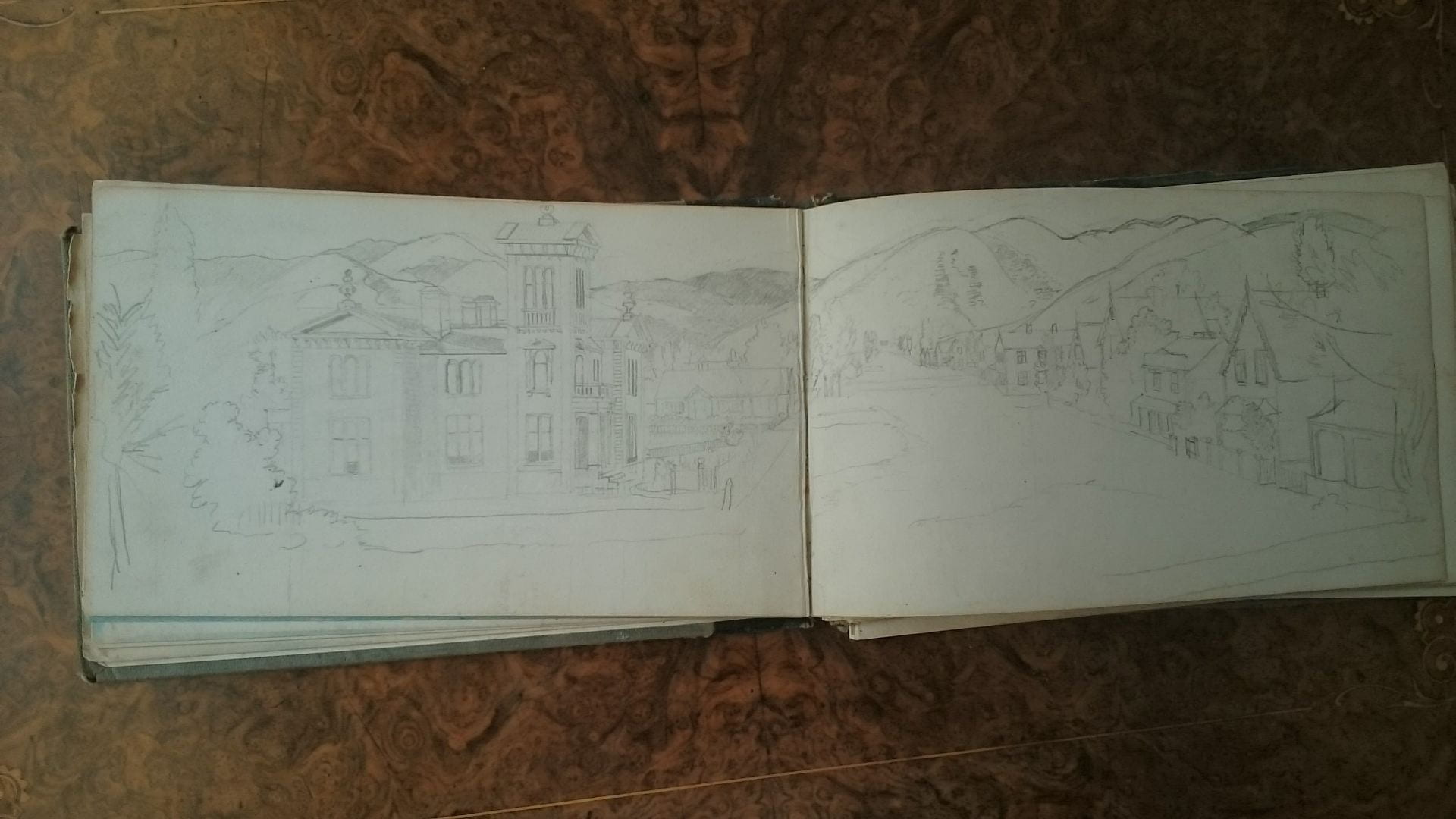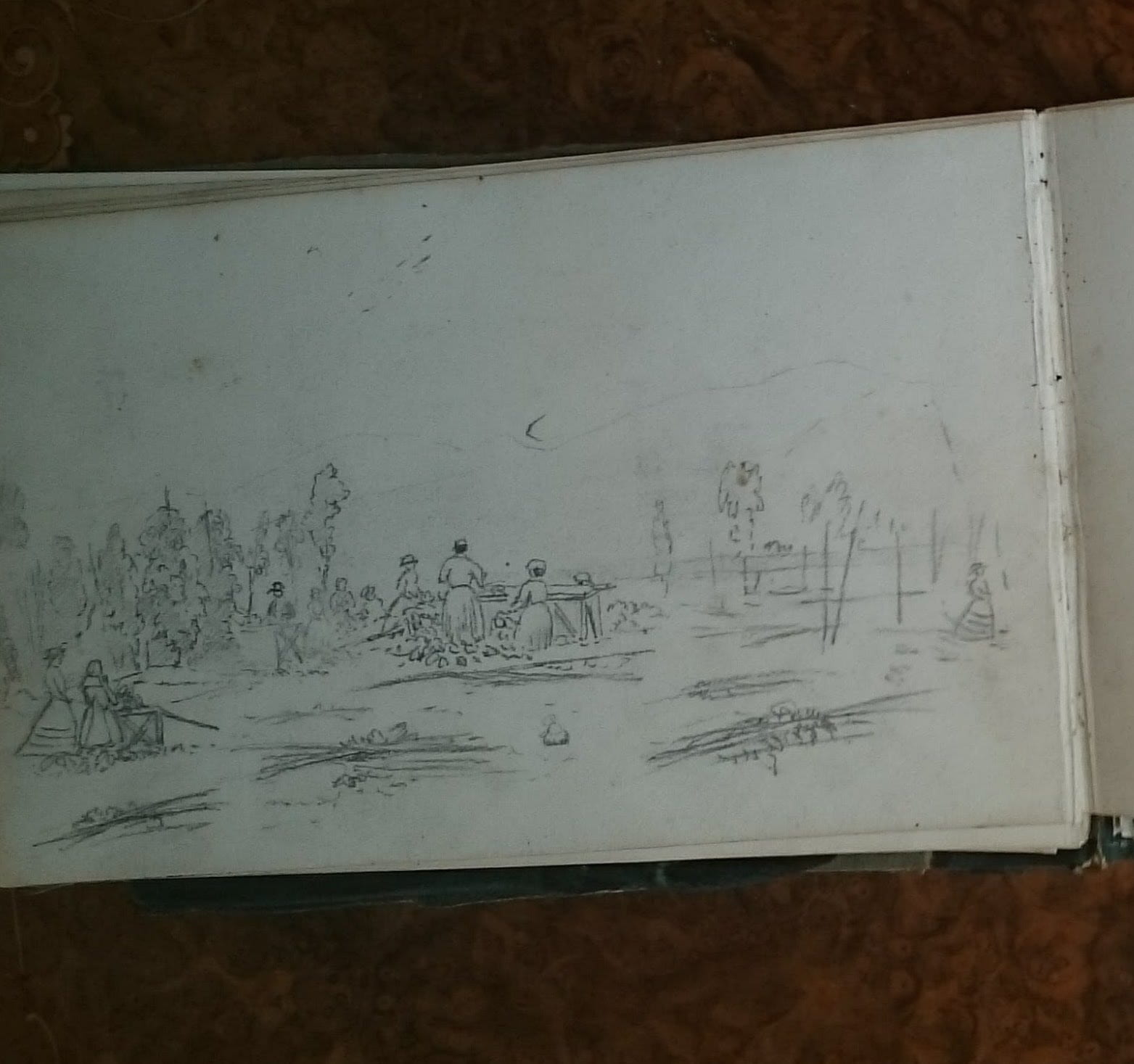Edwin Harris sketched his Nelson environs for over thirty years after settling there with his family in 1861. Nelson Provincial Museum holds a number of Edwin’s oil and watercolour landscapes, and Harris descendants hold two sketchbooks likely to contain studies for some of his finished paintings. We present below a preview of pages from the sketchbook now owned by Roseanne Cranstone of Whanganui. As summer arrives, we plan to upload images of both sketchbooks (the other one belongs to Godfrey and Judith Briant, Marton), so that Nelsonians and others can get a look at how Edwin represented town and country, coast and inland, peopled and unpeopled scenes that became working drawings for further development. Sometimes it is possible to identify a place (Nelsonians please help!) and occasionally Edwin himself identifies and dates a sketch. Both sketchbooks are well-worn and clearly accompanied the artist as he walked, drove or travelled by boat and train to local destinations. By comparing the sketchbooks with existing paintings, we hope to bring Edwin Harris’s Nelson career into focus as part of our interest in the Harris family artmaking.


The above sketch was likely a study for Edwin’s painting ‘Dr. Locking’s House, Nile St East’ held at the Nelson Provincial Museum.


Edwin’s dating of his watercolour of Bell Grove leads us straight to Emily’s 1886 diary. There we find out who went with Edwin on a holiday excursion to the well-known property once owned by the Bell and Morrison families:
Easter Monday. Father & Frances went by train to Bell Grove. Ellen staying at the Brownings, I stayed at home all day, partly because I was afraid to leave the house, partly because my back ached so, I thought I couldn’t sit in the train so long. Then it was just like my inconsistency to put up a shelf in the dining room over the door nearly up to the ceiling. I had had the shelf made, but the putting it up, no easy matter, first it was an inch too long, & I had to saw it off, then it was so heavy I could hardly lift it, then I could not put the screws quite in, & lastly after I had done it all & came down the steps to admire it, I found that after most careful measurement it was not level because the ceiling slanted down a little at one side, so I had to take it down again & allow for the ceiling not being level. I was quite exhausted when it was done, so I had my solitary dinner, after which it took me all the afternoon to stow away a lot of papers & pamphlets on the shelf, in front of them I put a neat row of books so that I think it is not only useful but does not look amiss. Anyone would wonder why I should spend my holiday doing all this but the fact is I could not have done it any other day, & if I got a man to do it the others would have been sure to object to its being put there. As it was no one noticed it for some time & then father said, ‘Oh, that’s where you put your shelf is it’. I was as tired as if I had been to Bell Grove. (26 Apr 1886)
The Colonist extends our view of Edwin (aged 80) and Frances (44) on the train to and from Bell Grove / Belgrove:
The experiment of running a cheap excursion train to Belgrove and back proved, at any rate, from a Railway point of view, an unqualified success. At ten o’clock yesterday morning the longest single train which has yet left the Nelson Station started for Belgrove, but though every available carriage was utilised, the 600 passengers were so crowded that although they appeared to be in excellent spirits, this was certainly not because they were enjoying comfort. A short time back, after much difficulty, an addition was made to the rolling stock on the local line, and but for that addition many of those who went down to the Station yesterday morning could not have been carried. However the success of the experiment made yesterday was so pronounced, that we hope similar excursions will be frequently announced in the future for they not only enable many to enjoy a pleasant outing who otherwise would not be disposed to leave Town, but must add considerably to the earnings of the line. On the arrival of the excursion train at Belgrove yesterday, many of the passengers walked up Spooner’s Range, from which a beautiful view is obtainable, whilst others picniced in the bush or strolled in the vicinity of Fox Hill. The return train left Belgrove at five o’clock, but having to pick up passengers by the ordinary trains, additional carriages had to be attached, and when the train came in it was packed completely. On the return journey the want of carriage accommodation was more keenly felt, for there was no standing room even in either carriages or trucks, and many were left behind at the several stations and had to come in by the latter train. The inconvenience and danger of having to ride in trucks was also made manifest, for all those who thought themselves fortunate enough to gain admission to the trucks were greatly inconvenienced by the smoke from the engines, whilst in three cases that we heard of sparks ignited the dresses of ladies. No doubt yesterday was an exceptional day on the railway, but after making ample allowance for this, it is evident that more rolling stock is necessary before the Railway Manager can provide for public requirements at holiday times, and we trust that additional carriages will at once be provided. The local manager and his staff did all that was possible on their part to make things go smoothly. (27 apr 1886)
Lead writer: Michele Leggott
Research support: Makyla Curtis, Betty Davis